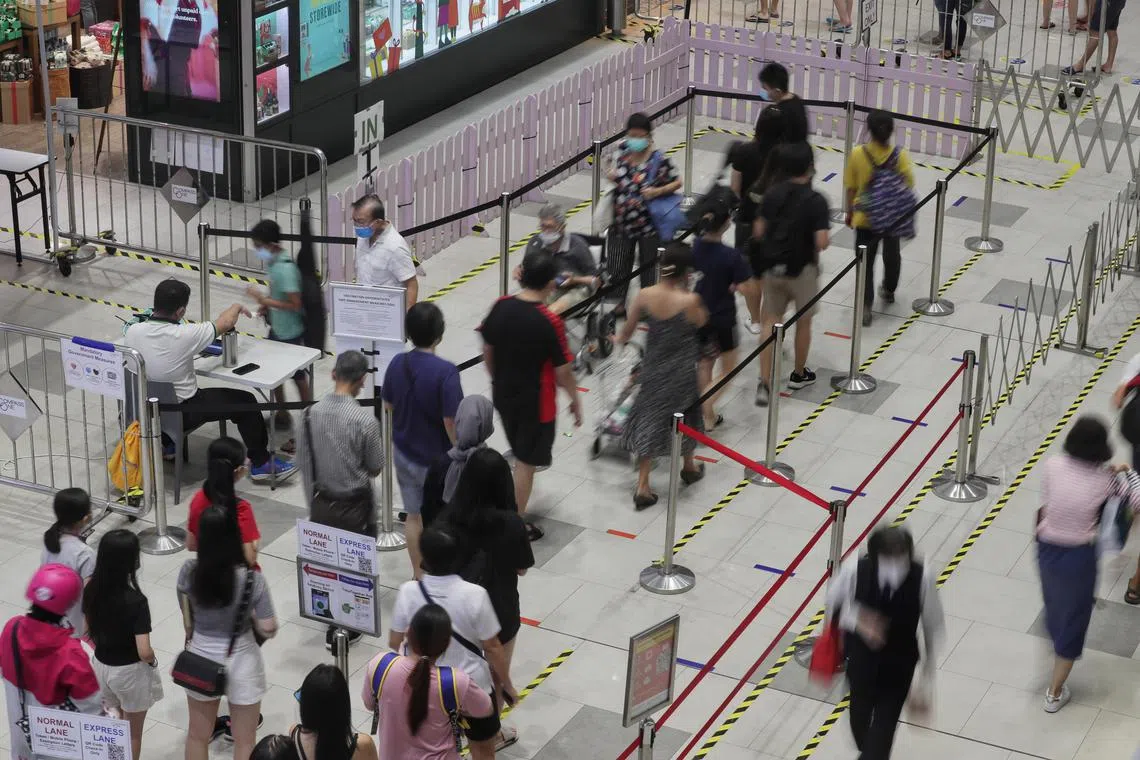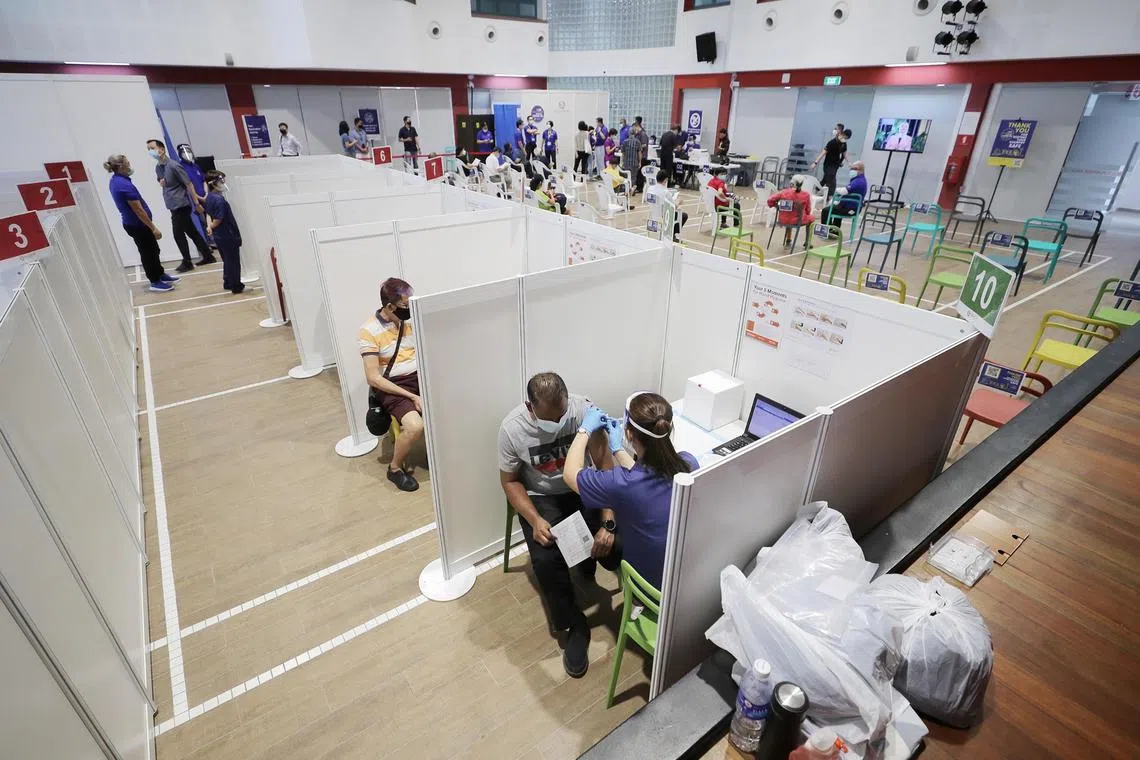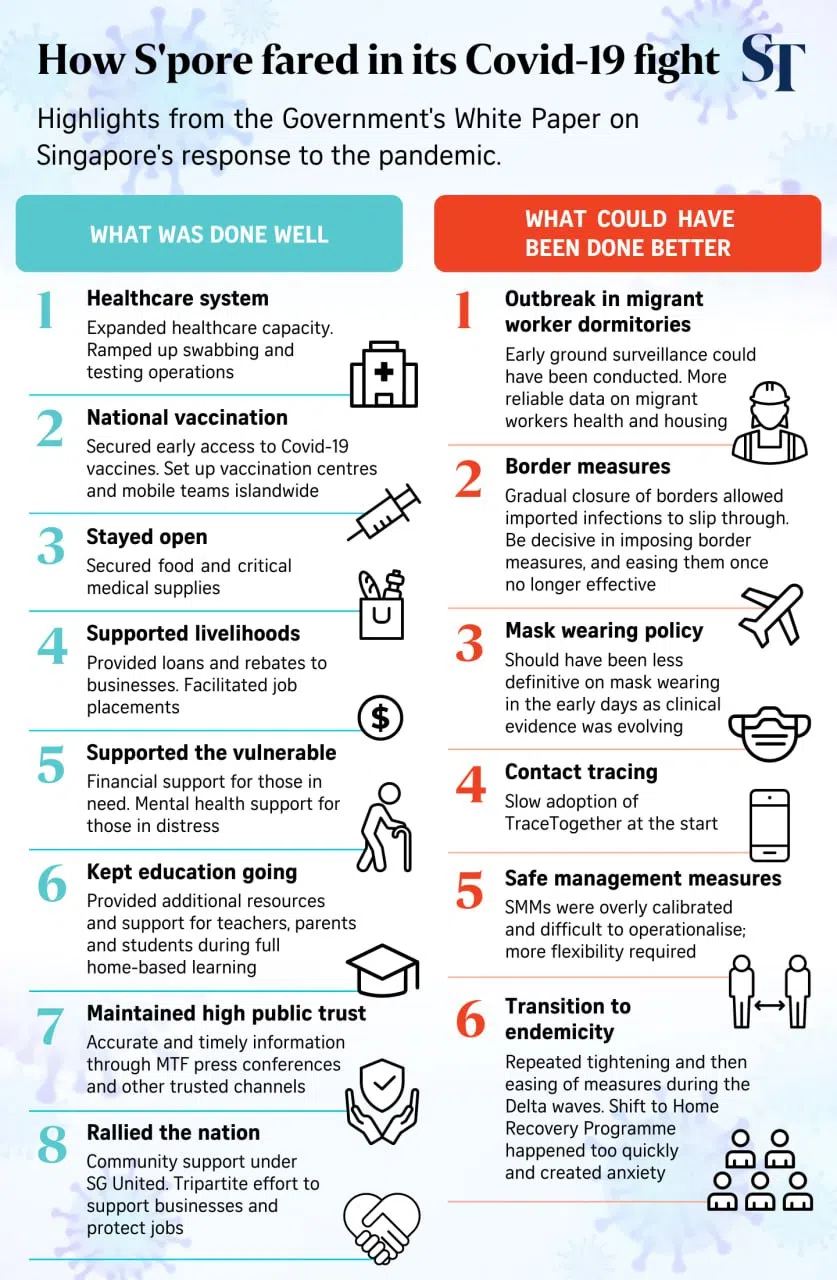The gist: Tackling ‘crisis within a crisis’ and other Covid-19 lessons for future pandemics
Sign up now: Get ST's newsletters delivered to your inbox

Some safe management measures were frequently changed owing to the evolving pandemic situation.
ST PHOTO: KELVIN CHNG
Follow topic:
SINGAPORE – On Wednesday, the Government released a White Paper on its response to Covid-19 over the past three years and the lessons learnt for future pandemics. Here are the key points:
1. Early access and smooth roll-out of vaccines

People receiving their Covid-19 shots at the vaccination centre in Jalan Besar Community Club on Feb 19, 2021.
ST FILE PHOTO
Singapore signed advance purchase agreements and made early down payments for the mRNA vaccines
When the vaccines arrived, ultra-cold chain logistics were put in place and vaccination centres were set up across the island within weeks, enabling the population to get their shots.
Why it matters
Singapore’s bet meant it was the first country in Asia to receive doses of the Pfizer-BioNTech vaccine, and by late August 2021, had vaccinated 80 per cent of its population.
In future outbreaks, Singapore aims to be able to administer vaccines to all aged 50 and above within three to four weeks by tapping primary care clinics if needed.
2. Outbreak in migrant worker dormitories

Migrant workers at the North Coast Lodge dormitory on April 17, 2020.
ST FILE PHOTO
Early on, insufficient measures taken in migrant worker dormitories resulted in nearly half of the 300,000 workers living in such facilities getting infected with Covid-19 by end-2020, though many showed no symptoms.
Extended restrictions on migrant workers even after most had been vaccinated and boosted helped keep them – and the broader community – safe, but took a toll on their mental well-being.
Why it matters
The White Paper noted that this “crisis within a crisis” was the most dangerous of the close calls Singapore had, as it could have spilt into the wider community and overwhelmed the healthcare system, which would have led to many deaths.
The experience underscored the need for more comprehensive medical support for migrant workers, and the Manpower Ministry has since established a primary healthcare system for these workers
3. Covid-19 rules and safe management measures

A wedding guest undergoing a Covid-19 swab test at Four Points by Sheraton Singapore on May 8, 2021.
ST FILE PHOTO
Some safe management measures were frequently changed owing to the evolving pandemic, with the public confused by instructions that were overly elaborate as well as difficult to operationalise and explain. Among these were rules governing events such as weddings, which included pre-event testing and restrictions on mingling.
There was also some unevenness in treatment when the Government defined rules for different categories of businesses after the circuit breaker period.
Why it matters
At times during the pandemic, Singapore “allowed the perfect to be the enemy of the good” when it over-calibrated some of its safety measures and treatment protocols. This highlights the need for the authorities to be more flexible in a crisis, and to go for broader brush strokes with more implementable measures.
To strike the right balance between precision and ease of implementation of public health protocols, the country needs to avoid ”unrealistic standards of perfection”.
4. Public communication through the pandemic

(From left) Singapore’s director of medical services Kenneth Mak and multi-ministry task force co-chairmen Lawrence Wong, Gan Kim Yong and Ong Ye Kung at a press conference on Feb 9.
ST PHOTO: KUA CHEE SIONG
Public trust was maintained through regular press conferences, daily case updates and a dedicated WhatsApp channel, with the authorities also tackling misinformation that could have caused panic and sapped confidence in the battle against Covid-19.
However, the Government’s change in stance on mask wearing in April 2020 after evidence emerged of the asymptomatic spread of Covid-19 was seen as a U-turn, and undoubtedly affected public trust and confidence in its handling of the crisis.
Why it matters
Accurate information was put out in a timely fashion through trusted channels, and the Government was upfront in communicating any bad news. Such transparency kept citizens informed and prepared for difficulties ahead, and was critical in addressing public concerns.
In hindsight, the Government could have been less definitive about masks early in the pandemic, given that clinical evidence was still evolving then. The country will also review how indicators of crisis severity such as the Dorscon (Disease Outbreak Response System Condition) alert level
If you have a few more minutes…
1. Reviewing the “insurance” Singapore buys
The pandemic highlighted the need for Singapore to strengthen its supply chain, with the authorities planning to review stockpiling strategies, build a more comprehensive list of critical items and expand source countries. The Republic may also diversify the sources of migrant labour, though it noted that the costs of buying such “insurance” will have to be carefully considered.
2. Dedicated forward-planning team, centralised assigning of crisis-time roles
A dedicated forward-planning team will be created for future pandemics, with the bandwidth and expertise to better anticipate and plan for situations that may arise. In addition, a more centralised system will be created to allow for crisis-time roles to be tagged to suitable individuals, who will be trained in advance to be redeployed quickly when mobilised.
3. Increasing flexibility of Infectious Diseases Act
Noting that the Infectious Diseases Act caters only to the binary scenarios of peacetime or emergency, the White Paper said the law was too constraining to calibrate public health measures as the situation evolves. The law should be reviewed to allow for more flexible and effective responses to the changing circumstances of a pandemic.
4. Better use of digital technology solutions
Digital technology solutions can be better employed in the next pandemic, with agencies such as the Smart Nation and Digital Government Office and GovTech activated earlier to integrate digital solutions with ground operations. Additionally, cyber security must be enhanced, given the increasing dependence on digital tools in crisis operations.
5. Developing effective data-sharing system
The Government will invest in data-engineering capabilities and interoperable systems across its agencies so that data from multiple sources can be tapped to quickly obtain a common picture of the ground situation in a pandemic. More effort will also be put into identifying important data from the private healthcare sector and how it can be effectively shared.
6. Differentiated approach to long-term pass holders
Travel restrictions created significant difficulties for some long-term pass holders who endured prolonged family separation and work disruptions. Future pandemics should see a more differentiated approach to border restrictions based on considerations such as keeping families together. This means Singapore must build its ability to quickly ramp-up quarantine capacity to safely accommodate those who need to return to the country.


